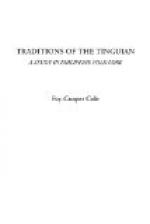While in the practice of magic, and in their communication with nature, celestial bodies, and spirits, these “people of the first times” far excelled the present Tinguian, they had a material culture and ceremonial life much like that still found in Abra.
It seems then that these people, about whom the stories cluster, are not to be identified as celestial beings or spirits [63]. They appear rather as generalized heroes whose life and deeds represent that of an earlier period, magnified and extolled by succeeding generations.
Ritualistic and Explanatory Myths
The second division of the tales now assumes a position of importance to us, for in it we find present day ideas and beliefs of the people strongly brought out, and are thus in a position to contrast them with the tenets of the people in “the first times”.
The influence of custom is exceedingly strong among the Tinguian of to-day. The fact that the ancestors did so and so is sufficient justification for performing any act for which they have no definite explanation. Nowhere is this influence greater than in the ceremonies. These, which accompany all the important happenings in their daily life, are conducted by mediums who are fitted for office by long training, and each one of whom is a check on the others if they wilfully or through carelessness deviate from the old forms. The ritual of these ceremonies is very complex and the reason for doing many acts now seems to be entirely lost, yet the one explanation "kadauyan"—custom—is sufficient to satisfy any Tinguian. Other acts, as well as the possession of certain things, are explained by myths, such as we are considering. It seems certain that we are here dealing not with present day beliefs alone, but with at least relatively old customs and tales, which while enabling us to understand present day conceptions also give us a glimpse into the past.
The myths 32-40, which are known to the people as diams, are now inseparable parts of the various ceremonies. Thus, when a pig is to be offered in the Sayang ceremony, the medium sits down beside it and strokes it with oiled fingers while she “talks to the spirits”. The translation of her “talk” shows that this is in no sense a prayer but is rather an account of how the greatest of the spirits taught the Tinguian people to perform this ceremony correctly. Likewise, when she offers food in the Dawak [64] ceremony, she relates how the spirit Kaboniyan taught the Tinguian to do this in the same manner that he performs it. In the Pala-an [65] diam she relates, in story form, the cause of the sickness, but in this case ends with a direct invocation to the spirits in Dadaya to “make them well again if you please”. The balance of the diams, 35-40, are in story form, and seem intended more as an explanation to the people as to the causes of their troubles than to be directed toward the spirits. However, the medium seldom has an audience, and rarely ever a single listener, as she recites the diams she has learned verbatim from her instructors when preparing for the duties of her office.




